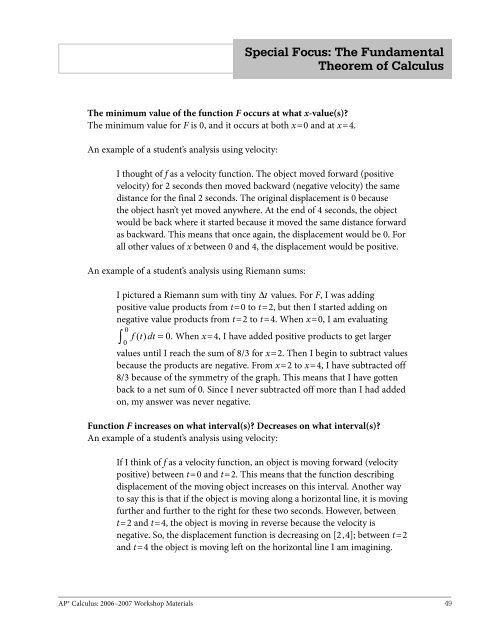AP Calculus
Calculus_SF_Theorem
Calculus_SF_Theorem
Create successful ePaper yourself
Turn your PDF publications into a flip-book with our unique Google optimized e-Paper software.
Special Focus: The Fundamental<br />
Theorem of <strong>Calculus</strong><br />
The minimum value of the function F occurs at what x-value(s)?<br />
The minimum value for F is 0, and it occurs at both x=0 and at x=4.<br />
An example of a student’s analysis using velocity:<br />
I thought of f as a velocity function. The object moved forward (positive<br />
velocity) for 2 seconds then moved backward (negative velocity) the same<br />
distance for the final 2 seconds. The original displacement is 0 because<br />
the object hasn’t yet moved anywhere. At the end of 4 seconds, the object<br />
would be back where it started because it moved the same distance forward<br />
as backward. This means that once again, the displacement would be 0. For<br />
all other values of x between 0 and 4, the displacement would be positive.<br />
An example of a student’s analysis using Riemann sums:<br />
I pictured a Riemann sum with tiny ∆t values. For F, I was adding<br />
positive value products from t=0 to t=2, but then I started adding on<br />
negative value products from t=2 to t=4. When x=0, I am evaluating<br />
0<br />
∫ f ( t) dt = 0.<br />
When x=4, I have added positive products to get larger<br />
0<br />
values until I reach the sum of 8/3 for x=2. Then I begin to subtract values<br />
because the products are negative. From x=2 to x=4, I have subtracted off<br />
8/3 because of the symmetry of the graph. This means that I have gotten<br />
back to a net sum of 0. Since I never subtracted off more than I had added<br />
on, my answer was never negative.<br />
Function F increases on what interval(s)? Decreases on what interval(s)?<br />
An example of a student’s analysis using velocity:<br />
If I think of f as a velocity function, an object is moving forward (velocity<br />
positive) between t=0 and t=2. This means that the function describing<br />
displacement of the moving object increases on this interval. Another way<br />
to say this is that if the object is moving along a horizontal line, it is moving<br />
further and further to the right for these two seconds. However, between<br />
t=2 and t=4, the object is moving in reverse because the velocity is<br />
negative. So, the displacement function is decreasing on [2,4]; between t=2<br />
and t=4 the object is moving left on the horizontal line I am imagining.<br />
<strong>AP</strong>® <strong>Calculus</strong>: 2006–2007 Workshop Materials 49


